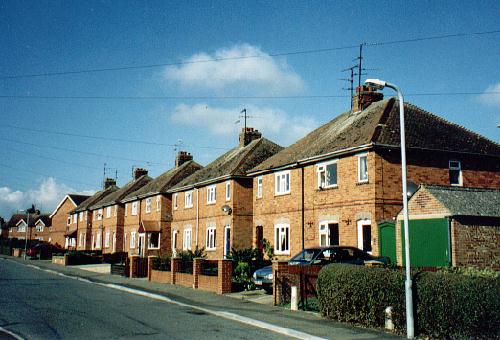|

THE BUILDING OF council houses by the local authority has been a major factor in the expansion of Bourne since 1900 and nowhere is this activity better illustrated than in Harrington Street. Between the wars, a considerable number of these properties were erected on the eastern side of the town, both houses and bungalows. The eastern part of the old Meadowgate Road, now called Manning Road, was developed in 1914 and 1919 and Alexandra Terraces were created between 1924 and 1925. Recreation Road received 42 council houses in a single year, 1928, and between then and 1930, a further 48 properties were erected in George Street. Harrington Street was named after Robert Harrington, the town's 17th century benefactor, and developed between 1936 and 1937 with a total of 44 houses and ten bungalows, all of which are in use today. Then soon after the end of the Second World War, building started again with the creation of additional streets and roads. Harrington Street was further extended between 1947 and 1950 with a different style of council housing while 70 more houses appeared in Ancaster Road. Queen's Road was established in 1953 with Edinburgh Crescent adjoining and by 1960, 118 council houses, bungalows and flats were built in these two roads while Kingsway appeared a few years later. New building activity during the first half of the 20th century altered the appearance of the town more rapidly than at any other time in its history. For example, in the years between 1914 and 1970, Bourne Urban District Council alone erected 546 houses, bungalows and flats while during the same period, there was extensive private residential development on the west side of the town, stretching out towards Bourne Woods. The council houses of past years were originally designed as accommodation for the working classes and have been built by local authorities for more than a hundred years. Intensive building programmes during that period, especially in the years following the two world wars, has left most localities with a row of these distinctive houses, constructed to a simple and similar design, but providing rented homes and gardens for families of modest means. The Conservative government under Margaret Thatcher changed the perception of the council house when their Housing Act of 1985 included a statutory Right to Buy entitlement, introduced to encourage home ownership, and this enabled thousands of sitting tenants purchase the properties in which they lived at discount prices. As owner-occupiers, they could then change the appearance of their homes to suit their own tastes and these changes invariably started with a new front door, a feature that today distinguishes the house that is now privately owned from that which is still rented and is much in evidence today in Harrington Street. Return to HOME PAGE MAIN INDEX
|